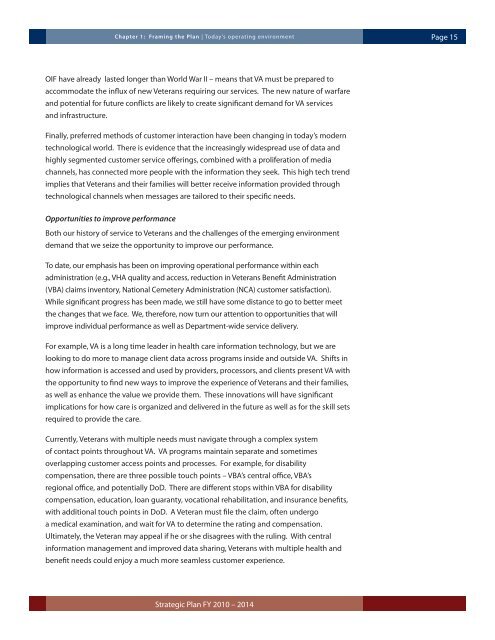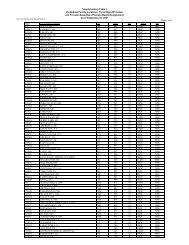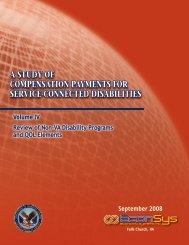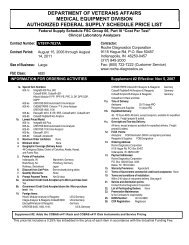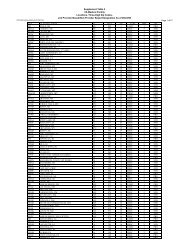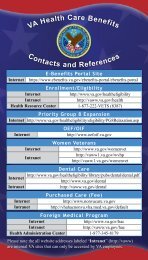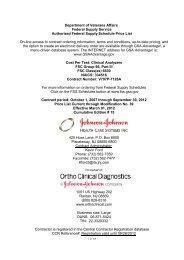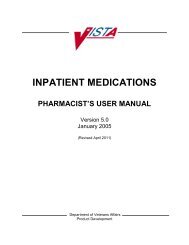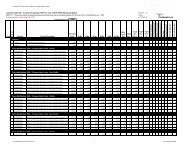VA Strategic Plan FY 2010-2014 - US Department of Veterans Affairs
VA Strategic Plan FY 2010-2014 - US Department of Veterans Affairs
VA Strategic Plan FY 2010-2014 - US Department of Veterans Affairs
- No tags were found...
Create successful ePaper yourself
Turn your PDF publications into a flip-book with our unique Google optimized e-Paper software.
Chapter 1: Framing the <strong>Plan</strong> | Today ’s operating environmentPage 15OIF have already lasted longer than World War II – means that <strong>VA</strong> must be prepared toaccommodate the influx <strong>of</strong> new <strong>Veterans</strong> requiring our services. The new nature <strong>of</strong> warfareand potential for future conflicts are likely to create significant demand for <strong>VA</strong> servicesand infrastructure.Finally, preferred methods <strong>of</strong> customer interaction have been changing in today’s moderntechnological world. There is evidence that the increasingly widespread use <strong>of</strong> data andhighly segmented customer service <strong>of</strong>ferings, combined with a proliferation <strong>of</strong> mediachannels, has connected more people with the information they seek. This high tech trendimplies that <strong>Veterans</strong> and their families will better receive information provided throughtechnological channels when messages are tailored to their specific needs.Opportunities to improve performanceBoth our history <strong>of</strong> service to <strong>Veterans</strong> and the challenges <strong>of</strong> the emerging environmentdemand that we seize the opportunity to improve our performance.To date, our emphasis has been on improving operational performance within eachadministration (e.g., VHA quality and access, reduction in <strong>Veterans</strong> Benefit Administration(VBA) claims inventory, National Cemetery Administration (NCA) customer satisfaction).While significant progress has been made, we still have some distance to go to better meetthe changes that we face. We, therefore, now turn our attention to opportunities that willimprove individual performance as well as <strong>Department</strong>‐wide service delivery.For example, <strong>VA</strong> is a long time leader in health care information technology, but we arelooking to do more to manage client data across programs inside and outside <strong>VA</strong>. Shifts inhow information is accessed and used by providers, processors, and clients present <strong>VA</strong> withthe opportunity to find new ways to improve the experience <strong>of</strong> <strong>Veterans</strong> and their families,as well as enhance the value we provide them. These innovations will have significantimplications for how care is organized and delivered in the future as well as for the skill setsrequired to provide the care.Currently, <strong>Veterans</strong> with multiple needs must navigate through a complex system<strong>of</strong> contact points throughout <strong>VA</strong>. <strong>VA</strong> programs maintain separate and sometimesoverlapping customer access points and processes. For example, for disabilitycompensation, there are three possible touch points – VBA’s central <strong>of</strong>fice, VBA’sregional <strong>of</strong>fice, and potentially DoD. There are different stops within VBA for disabilitycompensation, education, loan guaranty, vocational rehabilitation, and insurance benefits,with additional touch points in DoD. A Veteran must file the claim, <strong>of</strong>ten undergoa medical examination, and wait for <strong>VA</strong> to determine the rating and compensation.Ultimately, the Veteran may appeal if he or she disagrees with the ruling. With centralinformation management and improved data sharing, <strong>Veterans</strong> with multiple health andbenefit needs could enjoy a much more seamless customer experience.<strong>Strategic</strong> <strong>Plan</strong> <strong>FY</strong> <strong>2010</strong> – <strong>2014</strong>


